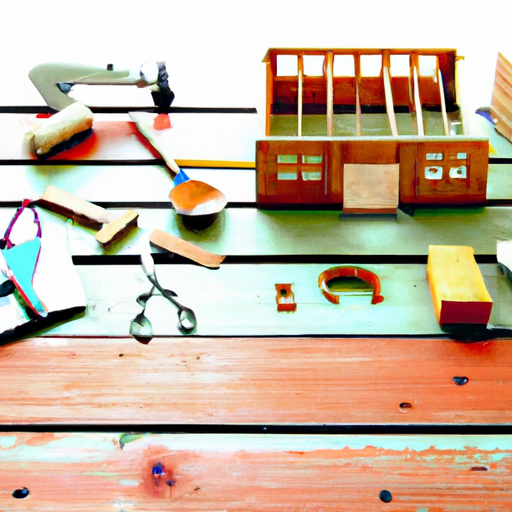Tackling a massive DIY project can feel overwhelming, with the sheer size of the task looming over you like a dark cloud. But fear not, because breaking it down into smaller, easier steps is the key to conquering it successfully. By taking this approach, you’ll not only feel less overwhelmed but also make progress more efficiently. In this article, we’ll explore various strategies to help you navigate the process and ensure you have a clear roadmap to follow every step of the way. So, let’s dive in and discover the secrets to making the seemingly impossible achievable.
 how t
how t
Identify the Project Scope
When faced with a large DIY project, the first step is to assess the overall scale of the project and determine its specific areas or tasks. This will help you gain a clear understanding of what needs to be done and what resources you will need. Consider whether any necessary research or planning is required before you can begin.
Assessing the overall scale of the project allows you to understand the magnitude of the work ahead. It’s important to have a clear picture of how big the project is so that you can plan accordingly and allocate sufficient time and resources. Whether you’re building a piece of furniture, renovating a room, or tackling a home improvement project, understanding the scale will help you set realistic expectations.
After determining the overall scale of the project, it’s time to break it down into specific areas or tasks. This step involves identifying the different components or stages of the project that need to be completed. For example, if you’re renovating a room, you might have tasks like painting the walls, installing new flooring, and replacing the light fixtures. Breaking down the project into smaller tasks helps make it more manageable and allows you to tackle one step at a time.
Lastly, consider any necessary research or planning that needs to be done before you can dive into the project. This might involve researching techniques and best practices, learning from online tutorials or guides, or consulting experts or experienced individuals. By gathering this information upfront, you’ll be better equipped to tackle the project efficiently and effectively.
Set a Realistic Timeline
Once you have a clear understanding of the project scope, it’s important to set a realistic timeline. This involves evaluating the available time and resources, breaking down the project into time increments, and allocating sufficient time for each step.
Evaluate the available time and resources you have for the project. Consider your schedule, commitments, and any external factors that may impact your timeline. It’s important to be honest with yourself about how much time you can realistically dedicate to the project.
Break down the project into smaller time increments. This could be weekly, daily, or even hourly depending on the complexity of the project. Breaking it down helps you see the progress you’re making and prevents it from feeling overwhelming. It also allows you to allocate sufficient time for each step, ensuring that you’re not rushing through any task.
When allocating time, consider the complexity and importance of each step. Some tasks may require more time and attention than others. Make sure to factor in any potential setbacks or delays that may arise along the way. It’s always better to have extra time than to feel rushed and compromise the quality of your work.
By setting a realistic timeline, you’re giving yourself the structure and guidance needed to complete the project successfully. It helps you stay motivated and focused as you have clear deadlines and goals to work towards.
Create a Detailed Plan
With the project scope and timeline in mind, it’s time to create a detailed plan. This involves listing all the required materials and tools, sketching out a rough outline of the project, and prioritizing tasks based on dependencies.
Start by listing all the required materials and tools for the project. This ensures that you have everything you need before you begin. It’s frustrating to realize halfway through the project that you’re missing a crucial tool or material. Make a comprehensive list and double-check it to avoid any unnecessary delays.
Next, sketch out a rough outline of the project. This can be a simple flowchart or a more detailed visual representation of the steps involved. Having a visual representation helps you see the big picture and understand how each task fits into the overall project. It also allows you to identify any potential roadblocks or dependencies between tasks.
Once you have the outline, prioritize tasks based on dependencies. Some tasks may need to be completed before others can begin. For example, if you’re building a piece of furniture, you may need to cut the wood before you can start assembling it. By prioritizing tasks based on dependencies, you ensure that you’re working in a logical order and maximizing efficiency.
Creating a detailed plan sets the foundation for a successful project. It helps you stay organized, ensures that all necessary materials and tools are accounted for, and allows you to have a clear roadmap for completing each task.
Gather Necessary Information
Before diving into the project, it’s important to gather necessary information. This involves researching techniques and best practices, learning from online tutorials or guides, and consulting experts or experienced individuals.
Researching techniques and best practices allows you to learn from others who have already tackled similar projects. It provides valuable insights and knowledge that can help you avoid common pitfalls and make your work more efficient. Take the time to read books, articles, and online forums to gather as much information as possible.
Online tutorials or guides can be a great resource, especially for visual learners. Many DIY websites and YouTube channels offer step-by-step instructions for various projects. Watching someone else go through the process can help you understand the techniques involved and gain confidence in your own abilities.
If possible, consult experts or experienced individuals who have expertise in the specific project you’re working on. They can provide valuable advice, answer any questions you might have, and offer guidance based on their own experiences. Learning from someone who has already been through the process can be incredibly beneficial and save you time and effort.
By gathering necessary information, you’re equipping yourself with the knowledge and skills needed to tackle the project effectively. You’ll feel more confident in your abilities and be better prepared to overcome any challenges that may arise.

Divide the Project into Phases
Dividing the project into phases helps break down the work into logical stages and allows you to focus on one piece at a time. It’s easier to manage and keeps you motivated as you complete each phase.
Start by identifying the different phases or stages of the project. These can be based on specific areas of the project or milestones you want to achieve. For example, if you’re renovating a room, the phases might include demolition, painting, flooring, and finishing touches.
Group related tasks together within each phase. This ensures that you’re focusing on similar tasks that require similar tools or materials. It also helps you stay organized and prevents any confusion or overlap between different parts of the project.
Determine milestones for each phase to track your progress. These milestones serve as checkpoints and allow you to celebrate your achievements along the way. Breaking the project into phases provides a sense of accomplishment as you complete each milestone, keeping your motivation and morale high.
Dividing the project into phases makes it more manageable and allows you to approach it systematically. You can focus on one phase at a time without feeling overwhelmed by the entire project. It also gives you a clear sense of progress as you complete each phase and move onto the next.
Break Down First Phase
Once you have divided the project into phases, it’s time to break down the first phase into smaller tasks. This involves identifying initial tasks to initiate the project, defining clear objectives for the first phase, and planning smaller steps within the phase.
Identify the initial tasks that need to be completed to start the project. These tasks are often the foundational steps that set the stage for the rest of the work. For example, if you’re building a piece of furniture, the initial tasks might include measuring and cutting the wood.
Define clear objectives for the first phase. This helps you stay focused and gives you a clear target to work towards. Objectives can be tangible, such as completing a specific task or milestone, or more abstract, such as gaining a certain level of understanding or proficiency.
Plan smaller steps within the phase to break down the objectives. These steps should be manageable and easy to tackle. Breaking them down into smaller tasks prevents you from feeling overwhelmed and allows you to make progress consistently.
By breaking down the first phase into smaller tasks, you’re setting yourself up for success from the start. It provides clarity on what needs to be done and helps you stay focused on each individual step. Celebrate each completed task or objective to maintain motivation and keep you energized for the rest of the project.

Prioritize and Order Tasks
When faced with a large DIY project, it’s important to prioritize and order tasks. This involves deciding on the most critical tasks, arranging tasks in a logical order, and considering dependencies between tasks.
Decide on the most critical tasks that need to be completed first. These are the tasks that have the biggest impact on the overall project or are essential for progress. By prioritizing these tasks, you ensure that you’re focusing on the most important aspects and not getting caught up in less significant details.
Arrange tasks in a logical order. Consider the dependencies between tasks and determine which tasks need to be completed before others can begin. For example, if you’re painting a room, it’s important to paint the walls before you can install the new flooring or hang the curtains. By arranging tasks in a logical order, you ensure a smooth flow of work and minimize any disruptions.
Consider dependencies between tasks to ensure a smooth workflow. Some tasks may rely on the completion of others, so it’s important to address those first. By considering dependencies, you prevent any delays or setbacks that may arise from tackling tasks out of order.
By prioritizing and ordering tasks, you optimize your workflow and ensure that you’re working efficiently. It helps you stay organized and focused on the most impactful aspects of the project.
Delegate Responsibilities
If you’re working on a DIY project as part of a team, it’s important to delegate responsibilities. This involves assigning specific tasks to team members, providing clear instructions and expectations, and ensuring that everyone understands their roles.
Assign specific tasks to team members based on their skills and strengths. Consider their expertise and interests when distributing the workload. By assigning tasks to the right individuals, you maximize efficiency and ensure that each task is completed to the best of their abilities.
Provide clear instructions and expectations to the team members. Make sure they understand what needs to be done, how it needs to be done, and any deadlines or milestones they need to meet. Clear communication is key to successful delegation and ensures that everyone is on the same page.
Ensure that everyone understands their roles and responsibilities. Check in with team members regularly to address any questions or concerns they may have. By fostering a collaborative and supportive environment, you create a strong team that works together towards a common goal.
Delegating responsibilities allows you to leverage the skills and expertise of your team members. It prevents you from feeling overwhelmed and ensures that each task is completed efficiently and effectively.

Establish Quality Checkpoints
To ensure the quality of your work, it’s important to establish quality checkpoints throughout the project. This involves defining criteria to assess completion of tasks, creating benchmarks to track progress, and reviewing and validating completed work.
Define criteria to assess completion of tasks. These criteria can be based on specific measurements, standards, or quality indicators. For example, if you’re painting a room, the criteria might include even coverage, no visible brush strokes, and clean lines along edges. Clearly defining the criteria allows you to evaluate the completion of tasks objectively.
Create benchmarks to track progress. These benchmarks serve as milestones or checkpoints to monitor your progress throughout the project. They can be based on specific tasks or phases. Regularly assessing your progress against these benchmarks helps you stay on track and identify any areas that need improvement.
Review and validate completed work to ensure it meets the established criteria. This step is crucial for maintaining the quality of your project. Take the time to carefully inspect each task and make any necessary adjustments or corrections. By validating completed work, you ensure that each task is up to your standards before moving on to the next.
Establishing quality checkpoints helps you maintain high standards throughout the project. It allows you to catch any mistakes or issues early on, preventing them from becoming bigger problems later. Regular evaluation and quality control ensure that the end result is a project you can be proud of.
Celebrate Milestones
As you make progress on your DIY project, it’s important to acknowledge and celebrate milestones. This involves acknowledging and rewarding achievements, taking breaks or celebrating completed phases, and maintaining motivation and morale.
Acknowledge and reward achievements, both big and small. Recognize the hard work and effort put into completing each task or milestone. This can be as simple as giving yourself a pat on the back or treating yourself to something special. Celebrating achievements helps boost motivation and confidence as you see the progress you’ve made.
Take breaks or celebrate completed phases to recharge and rejuvenate. Large DIY projects can be mentally and physically demanding, so it’s important to schedule breaks to rest and recover. Celebrating the completion of phases can be a fun and rewarding way to mark the progress you’ve made. It gives you a sense of accomplishment and allows you to reflect on the hard work you’ve put in.
Maintain motivation and morale throughout the project. Celebrating milestones and achievements helps keep the momentum going. Remind yourself of why you started the project in the first place and the satisfaction that comes from completing it. Surround yourself with positive and supportive people who can encourage and motivate you along the way.
By celebrating milestones, you create a positive and rewarding experience throughout the project. It keeps you motivated, boosts morale, and makes the entire journey more enjoyable.
Breaking down a large DIY project into smaller, more manageable steps is an essential skill for any DIY enthusiast. By identifying the project scope, setting a realistic timeline, creating a detailed plan, gathering necessary information, dividing the project into phases, breaking down the first phase, prioritizing and ordering tasks, delegating responsibilities, establishing quality checkpoints, and celebrating milestones, you can successfully tackle any project with confidence. Take it one step at a time, and you’ll be amazed at what you can accomplish. Happy DIY-ing!











